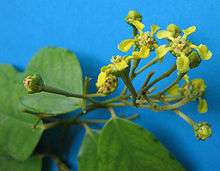Heteropterys
| Heteropterys | |
|---|---|
 | |
| Heteropterys chrysophylla Kunth | |
| Scientific classification | |
| Kingdom: | Plantae |
| (unranked): | Angiosperms |
| (unranked): | Eudicots |
| (unranked): | Rosids |
| Order: | Malpighiales |
| Family: | Malpighiaceae |
| Genus: | Heteropterys H. B. K. |
| Species | |
|
Over 140 species; see text | |
Heteropterys is a genus in the Malpighiaceae, a family of about 75 genera of flowering plants in the order Malpighiales. Heteropterys comprises over 140 species of woody vines, shrubs, and small trees found in the New World tropics and subtropics from northern Mexico and the West Indies to northern Argentina and southeastern Brazil. One widespread, mostly Caribbean species, H. leona, is also found in low wet places along the coast of West Africa from Senegal to Angola.[1]
Heteropterys aphrodisiaca O. Mach., endemic to the Brazilian scrubland regions, is traditionally used in folk medicine as an aphrodisiac, a stimulant and in the treatment of nervous weakness.[2] The herb has been found to reduce the toxic effects of cyclosporin A on rat testis,[3] increase tendon strength with endurance training in rats,[4] and improve memory in aged rats.[5] Additionally, an aliphatic nitro compound extracted from the root was found to have antimicrobial[6] and antiviral effects[7] in vitro.
References
- ↑ Anderson, C. 2001. The identities of two water-dispersed species of Heteropterys (Malpighiaceae): H. leona and H. platyptera. Contributions from the University of Michigan Herbarium 23: 35–47.
- ↑ Pott, A., Pott, V.J., 1994. Plantas do Pantanal. EMBRAPA–SPI, Corumba´, p. 101.
- ↑ Juliana C. Monteiro, Fabri´cia S. Predes, Se´rgio L.P. Matta, And Heidi Dolder. (2008) “Heteropterys aphrodisiaca Infusion Reduces the Collateral Effects of Cyclosporine A on the Testis”. The Anatomical Record 291:809-817
- ↑ Juliana C Monteiro, Marcos LM Gomes, Tatiana C Tomiosso, Wilson R Nakagaki, Mariana M Sbervelheri, Danilo L Ferrucci, Edson R Pimentel, and Heidi Dolder. “More resistant tendons obtained from the association of Heteropterys aphrodisiaca and endurance training”. BMC Complementary and Alternative Medicine 2011, 11:51
- ↑ S.M.P. Galva˜o, L.C. Marques, M.G.M. Oliveira, E.A. Carlini. “Heteropterys aphrodisiaca (extract BST0298): a Brazilian plant that improves memory in aged rats”. Journal of Ethnopharmacology 79 (2002) 305311
- ↑ Walter Antônio Roman Júnior, Mara Lane Carvalho Cardoso, Wagner Vilegas, Celso Vataru Nakamura, Benedito Prado Dias Filho, and João Carlos Palazzo De Mello. 2005. "2,3,4,6-Tetra-O-(3-nitropropanoyl)-O- β -D-glucopyranoside, a New Antimicrobial from the Roots of Heteropteris aphrodisiaca". Acta Farm. Bonaerense 24(4): 543-5
- ↑ Fernando L. Melo, Fabricio J. Benati, Walter Antonio Roman Junior, Joa˜o Carlos Palazzo de Mello, Carlos Nozawa, Rosa Elisa Carvalho Linhares. 2008 "The in vitro antiviral activity of an aliphatic nitro compound from Heteropteris aphrodisiaca" Microbiological Research. 163: 136—139
External links
- Malpighiaceae Malpighiaceae - description, taxonomy, phylogeny, and nomenclature
- Heteropterys